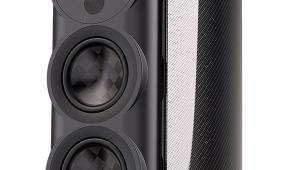System Audio saxo 40 Loudspeaker Page 2
![]() Star Turn
Star Turn
Many will admire the saxo 40 for its bijou construction but wonder if its size limits its performance, and when it comes to soundstaging it does, to a certain degree. However, System Audio's double contingent of bass/mid drivers means it never sounds small or shy – this speaker feels like it has an awful lot of heave and ho in reserve considering it sells for just under a grand. Indeed, its bass handling is often its star turn, even while the saxo 40 has been tuned to deliver a top end that sparkles without sounding overly bright or brittle.
Give the speaker pairing a push from a reasonably proficient amp (there's not the feeling of valve-friendly sensitivity here) and you're rewarded with a lively, dynamic sound that you might not be expecting. Such a performance came with Arch Enemy's 2017 album Will To Power [Century Media 88985458362], which finds the Swedish metal group in typically assured form, mixing ferocious blast beats with euphoric melodies and plenty of distortion. 'Set Flame To The Night' needed the saxo 40 to separate the twin guitar parts – and wailing police siren in the background – to keep it listenable as the mix thickened. It then leapt gleefully into 'The Race', slamming out the million-miles-per-minute drums with appreciable heft and capturing the snarl of Alyssa White-Gluz's almost impenetrable vocals.
This isn't a piece that requires much in the way of subtle imaging or tonal acrobatics. Mike Oldfield's 'Cochise' […The Best Of: 1992-1993; Warner Music; Tidal MQA], on the other hand, is all about the variances in his guitar tones, the sedate pacing, and ethereal backing track. Notes are left to ring out, and the saxo 40 did a good job of intimating an open, airy mix. I did crave more presence in the midband, however, to really let me zone in on Oldfield's playing, while I also missed the upbeat nature the speaker had shown earlier.

Thrill Of It All
Right on cue, my Tidal desktop app threw up another track named 'Cochise', this time by a duo named Orson Welsh and DJ Maus, from a compilation album titled Big Room Bangers, Vol. 21 [44.1kHz/16-bit]. This, with its pounding kick drums, deep bass and male vocals, sounded hugely thrilling.
In his Lab Report PM notes the low position of the saxo 40's tweeter, and it does make this speaker one that's both a little odd to look at and odd to listen to. I had no issues with it from my seating position, but standing up to leave the room brought a noticeable change in its frequency characteristic. The jangly guitars of The Bluetones' 'Talking To Clarry' [Expecting To Fly; Mercury 5316570] became somewhat dulled, and, more so than with other floorstanders, I felt I could peer 'over the top' of the soundstage. Back in the vertical sweet spot, however, singer Mark Morris's soft, pleading vocals enjoyed good projection.
Dire Straits' 'Telegraph Road '[Love Over Gold; Vertigo 800 088-2], a track that seems to have been designed to torture hi-fi systems, was revealing. Opening high-frequency keyboard whistles had a slightly gritty texture, sounding momentarily discordant rather than sweet and pure, but way below these the speaker latched on to the deep synthesiser hums.
On A Mission
Mark Knopfler's simplistic, two-note calling card was clean and clear, cutting through a little more than the background percussion. His vocals had an authentic texture, but what was perhaps most impressive was the saxo 40's presentation of John Illsley's bass playing, his runs up and down the fretboard sounding unencumbered by bloom or smear, and part of a bigger musical picture without dominating. System Audio doesn't supply any foam inserts to short the saxo 40's bass-reflex port, and the speaker doesn't need it.
The Dire Straits track ends with an extended outro where piano chords fight for space with crash cymbals, bass guitar and hard-hit snares, and the saxo 40 kept pace in terms of both rhythm and dynamics. And with Lorne Balfe's orchestral/electronic hybrid score for Mission: Impossible – Fallout [Paramount Music; 44.1kHz/16-bit download], which is packed with low brass and strings, dramatic crescendos and rat-a-tat percussion, it sounded big, as advertised. Mission accomplished.
Hi-Fi News Verdict
SA's compact floorstander isn't going to crush you with a wall of sound, but weigh this against its accommodating size and price point and it retains plenty of appeal. Thanks to its bass/mid twin-set, the saxo 40 has a low-end poise that belies its dimensions, coupled with a lively demeanour that makes the speaker a great partner for upbeat, full-range music. And you can put it wherever you want…

















































